Podcast
Questions and Answers
What is the most important reason for doing a vehicle inspection?
What is the most important reason for doing a vehicle inspection?
Safety
What things should you check during a trip?
What things should you check during a trip?
Watch gauges, mirrors, and use your senses to check for problems.
Name some key steering system parts.
Name some key steering system parts.
Steering wheel, tie rod, steering shaft, hydraulic fluid reservoir, gear box, pitman arm, drag link, steering knuckle, spindle, steering arm, power steering cylinder
Name some suspension system defects.
Name some suspension system defects.
What three kinds of emergency equipment must you have?
What three kinds of emergency equipment must you have?
What is the minimum tread depth for front tires? For other tires?
What is the minimum tread depth for front tires? For other tires?
Name some things you should check on the front of your vehicle during the walk around inspection.
Name some things you should check on the front of your vehicle during the walk around inspection.
What should wheel bearing seals be checked for?
What should wheel bearing seals be checked for?
How many red reflective triangles should you carry?
How many red reflective triangles should you carry?
How do you test hydraulic brakes for leaks?
How do you test hydraulic brakes for leaks?
Why put the starter switch key in your pocket during the pre-trip inspection?
Why put the starter switch key in your pocket during the pre-trip inspection?
Why should you back towards the driver's side?
Why should you back towards the driver's side?
If stopped on a hill, how can you start moving without rolling back?
If stopped on a hill, how can you start moving without rolling back?
When backing, why is it important to use a helper?
When backing, why is it important to use a helper?
What's the most important hand signal that the helper should agree on?
What's the most important hand signal that the helper should agree on?
What are the two special conditions where you should downshift?
What are the two special conditions where you should downshift?
When should you downshift automatic transmissions?
When should you downshift automatic transmissions?
Retarders keep you from skidding when the road is slippery.
Retarders keep you from skidding when the road is slippery.
What are the two ways to know when to shift?
What are the two ways to know when to shift?
How far ahead does the manual say you should look?
How far ahead does the manual say you should look?
What are the two main things to look for ahead?
What are the two main things to look for ahead?
What's the most important way to see the sides and rear of your vehicle?
What's the most important way to see the sides and rear of your vehicle?
What does 'communicating' mean in safe driving?
What does 'communicating' mean in safe driving?
Where should your reflectors be placed when stopped on a divided highway?
Where should your reflectors be placed when stopped on a divided highway?
What three things add up to total stopping distance?
What three things add up to total stopping distance?
If you go twice as fast, will your stopping distance increase by two or four times?
If you go twice as fast, will your stopping distance increase by two or four times?
Empty trucks have the best braking.
Empty trucks have the best braking.
What is hydroplaning?
What is hydroplaning?
Study Notes
Vehicle Inspection and Safety
- Vehicle inspections are essential for ensuring the safety of the driver and other road users.
- During trips, continuously monitor gauges, mirrors and utilize sensory checks—LOOK, LISTEN, and SMELL for any issues.
Key Components and Defects
- Important steering system components include: steering wheel, tie rod, steering shaft, hydraulic fluid reservoir, gearbox, pitman arm, drag link, steering knuckle, spindle, steering arm, and power steering cylinder.
- Common suspension system defects consist of: cracked or broken spring hangers, missing or damaged leaf spring leaves, leaking shock absorbers, and damaged or leaking air suspension systems.
Emergency Equipment
- Required emergency items: fire extinguisher, three reflective triangles, and spare fuses.
Tire Specifications
- Minimum tire tread depth: 4/32 inch on front tires, 2/32 inch on other tires; no fabric should show through tread or sidewall.
Walk Around Inspection
- Check the condition of the front axle, steering system, windshield, and lights/reflectors.
Wheel Bearings and Safety
- Wheel bearing seals should be inspected for leaks.
- Carry three red reflective triangles for emergency situations.
Brake System Checks
- Test hydraulic brakes for leaks by pumping the pedal and holding it; no movement indicates no leaks.
Pre-Trip and Backing Procedures
- Keep the starter switch key in your pocket during inspections to prevent unauthorized vehicle movement.
- When backing, favor the driver's side for better visibility of the vehicle's rear.
Hill Starting and Downshifting
- To avoid rolling back when starting on a hill, partially engage the clutch before releasing the brake.
- Use downshifting when approaching a hill or entering a curve to maintain control.
Automatic Transmission Shifting
- Downshift automatic transmissions when descending grades.
Retarders and Traction
- Retarders can cause skids on slippery surfaces; disable them in wet, icy, or snowy conditions.
Shifting Techniques
- Shift based on engine speed (rpm) or road speed (mph) indicators.
- Look 12 to 15 seconds ahead while driving, equal to about a block at lower speeds or a quarter mile at highway speeds.
Awareness and Communication
- Focus on traffic and road conditions while driving.
- Use mirrors to monitor surroundings for visibility on sides and rear of the vehicle.
- Communicate with other drivers through horn tapping, turn signals, and brake light activation.
Reflector Placement and Stopping Distance
- Place reflectors at intervals of 10, 100, and 200 feet from the vehicle when stopped on a divided highway.
- Total stopping distance is calculated as: Perception Distance + Reaction Distance + Braking Distance.
Effects of Speed on Stopping Distance
- Doubling speed increases stopping distance by four times.
- Contrary to popular belief, empty trucks require greater stopping distances due to reduced traction and potential wheel lock-up.
Hydroplaning Definition
- Hydroplaning occurs when a vehicle's tires lose contact with the road due to water, causing loss of control.
Studying That Suits You
Use AI to generate personalized quizzes and flashcards to suit your learning preferences.
Description
Test your knowledge on Class F vehicle inspections with these flashcards. Covering essential safety checks and steering system components, these cards will help reinforce your understanding of road safety and vehicle maintenance. Perfect for learners preparing for their driving tests.




